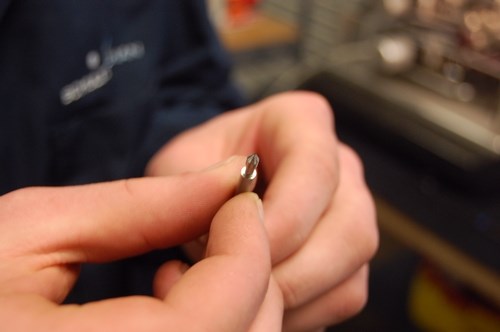Micromachining: Drilling Is Doable
This shop drills 0.020-inch holes as part of a machining cycle that also includes full-size tools cutting full-size features.
Share



Hwacheon Machinery America, Inc.
Featured Content
View More




The video footage accessible through the link at right shows the machining of an angle-of-attack sensor for an aerospace application. The part was designed by Schultz-Creehan, an engineering firm in Blacksburg, Virginia. The firm was then asked to machine the part as well—an unexpected challenge that the company rose to as well.
Schultz-Creehan co-founder and chief technology officer Jeff Schultz, Ph.D., says the straightness and position of the tiny holes in the part are critical. The holes in the video are 0.020 inch diameter and 0.335 inch deep. Holes machined in a comparable critical part the company produces are 0.020 inch diameter and 1.5 inch deep. At first, the firm’s machining area used small-hole EDM to make such holes, assuming EDM to be the optimal approach. But as the specified material for the sensor part changed from superalloy to stainless steel, the work moved to a small CNC machining center from Cameron Micro Drill Presses.
Dr. Schultz says using drilling instead of EDM offers multiple advantages. The shop found hole straightness easier to control with drilling. In addition, using a machining center allows most of the rest of the machining for the part to be performed in the same setup. That is what the video shows—a machining cycle that involves both micromachining and full-scale machining.
In fact, the Cameron machine was selected largely for this reason. In addition to the precision for microdrilling, the machine also offers the capacity for the tools used in the full-scale work, as well as enough travels to allow for a 4th-axis rotary table to be included in the work zone.
Dr. Schultz says the company has learned several lessons about drilling tiny holes efficiently. They include:
● “Pecking is the order of the day,” he says. The video shows how frequently the tool pecks to descend into the hole. This prevents any build-up of chips from increasing the force on the tool to even a small degree.
● Touching off to locate the part is difficult, he says. With magnification, it can be done. However, the shop has taken to relying on video edge finding instead. (The video shows this.)
● Question your intuition, he says. Reasonable parameters for a 0.020-inch drill are likely to seem too aggressive. “You think the tool can’t possibly stand up to the parameters you are contemplating,” he says. But it can.
Microdrilling simply requires more care than conventional-size drilling, he adds. However, once the company had done the work for a while, it no longer seemed all that small.
Related Content
-
Selecting a Thread Mill That Matches Your Needs
Threading tools with the flexibility to thread a broad variety of holes provide the agility many shops need to stay competitive. They may be the only solution for many difficult materials.
-
How to Accelerate Robotic Deburring & Automated Material Removal
Pairing automation with air-driven motors that push cutting tool speeds up to 65,000 RPM with no duty cycle can dramatically improve throughput and improve finishing.
-
Orthopedic Event Discusses Manufacturing Strategies
At the seminar, representatives from multiple companies discussed strategies for making orthopedic devices accurately and efficiently.









































.png;maxWidth=300;quality=90)


